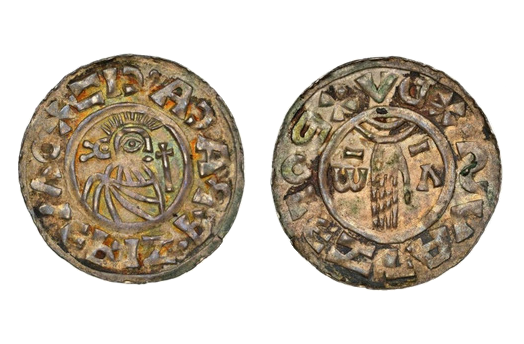
about ancient nomos
Ancient Nomos Art is a museum of galleries exhibiting ancient coins and ancient mint maps. The coin gallery displays the diverse art and history of hand-crafted ancient Greek, Roman, Byzantine, Persian and Medieval coinage. The ancient mints mapping gallery features Greek, Roman, Byzantine, Asia Minor and Medieval mint city regions and territories. Visitor's are welcome to explore, study and enjoy Ancient Nomos Art.

Medieval Prague – 980 AD
Boleslav II
From Ancient Galleries

Obverse: Manus Dei hand emerging downward from clouds above; ω and Λ, each with macron above, flanking the fields around the hand.
Reverse: Diademed and draped bust of Bohemia Duchy Boleslav II facing right; Latin cross before; PRAGA CIV(itas) Latin legend.
LEGEND
Obv: BOLEZLAVS XVD (retrograde), Manus Dei emerging from clouds; ω and Λ, each with macron above, flanking the hand. Rev: +OMERIZ · PRAGA · CIV (retrograde), diademed and draped bust facing right; Latin cross before.
The first medieval Prague mint (a.k.a. Bohemia (Czech) mint) was located in the city’s Vyšehrad (VVISEGRAD) “old town” castle district. The Vyšehrad area is a historic medieval hillside bastion, castle and fortress built on a large rock above the right bank of the Vltava River. This southern edge of the old historic city center is now now commonly referred to as the Vyšehrad district. The Prague mints first coinage production dates back to the late 10th century under the reign of Boleslav I. The early medieval Prague mint activity archive evidence are the silver coin legend engravings hand struck with the Latin city description “PRAGA CIVITAS”. Civitas marks the origin and place of origin of that coin and appears on many early medieval mint coins. The first coin minted in the Prague mint was the denar. These first Czech silver coins, were minted during the reigns of Duchy Boleslav I and Boleslav II. Their coinage named the ruler in the legends which ended with the word DUX (Duke or Sovereign) and the reverse the named Prague (PRAGA CIVITAS) as the place where the coins were minted. The origin of the oldest Czech denarii is placed just before the year 970, perhaps at the end of the reign of the mighty Boleslav I (935 – 972). The medieval Boleslav I denar types were based on the similar ‘Hand of God penny’, introduced in England by Aethelred II after 979 (SCBC 1144). The Prague mint moneyer Omer is thought to have been a Jewish merchant living in Prague. Before this time, barter of goods, such as fine scarves or woolens, were used as currency in the Czech Republic. We learn this from the report of the Arab traveler Ibrahim ibn Ya’kúb, who visited Bohemia sometime in the middle of the 10th century. According to Ya’kúb’s testimony, one denarius was worth ten scarves. The early Bohemia coinage of the Czech Boleslavs were strongly influenced by English styles and minting imagery. The so-called elhelredský, respectively the Anglo-Saxon type of Czech denarii shows the right hand of God on the obverse, later supplemented on the sides with the letters alpha and omega, which were supposed to symbolize the beginning and the end. On the reverse, the engraver depicted the figure (bust) of the prince. Faithful imitation of the mints of King Ethelred II of England. (978 – 1016) was enhanced by the inclusion of his name on one of Prince Jaromír’s denarii (1003, 1004 – 1012, 1033 – 1034) minted after 1004. The reason for such a detailed imitation can be found in the use of Czech coins in international trade, where Anglo-Saxon coins became domesticated much earlier.
DOCUMENTATION
Value: Denar. Metal: AR Silver. Weight: 1.22 grams. Mint: Praha (Prague) mint; Omer, moneyer. Date: Struck after 979 AD.
Attribution: Friedenberg, Jewish p. 14 (this coin illustrated); Frynas B.1.24; Šmerda 31. Photo courtesy NGC,The Historical Scholar Collection, Part IV.
Legend, Documentation and Attribution
